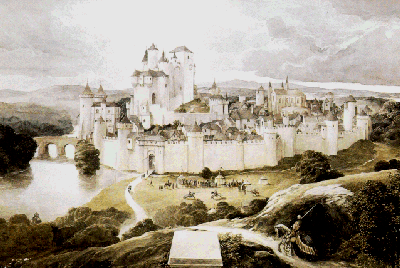
CAMELOT

Camelot was the most famous castle in the medieval legends of King Arthur,
and where, according to legend, he reigned over Briton before the Saxon
conquest. At Camelot Arthur established a brilliant court and seated the
greatest and most chivalrous warriors in Europe, the Knights of the Round
Table. Camelot was the starting point of the Quest for the Holy Grail, and
by the 1200's, it came to symbolize the center of the Arthurian world.
The oldest known stories of Arthur don't refer to Camelot by name. It is
first mentioned explicitly in the romance Lancelot written by Chretien de
Troyes in the twelfth century. Different writers throughout the ages have
placed Camelot in different locations. Sir Thomas Malory, in Le Morte
D'arthur (15th century), placed the castle in Winchester. Geoffrey of
Monmouth, in his History of the Kings of Britain (about 1136) named Caerleon
Castle in Wales. Another theory puts Camelot near Tintagel, Arthur's reputed
Cornish birthplace. According to the romancers, Camelot was named after a
pagan king called Camaalis. Modern attempts at identifying Camelot have
sought to place Camelot at the ruins of Cadbury Castle in Somerset, excavated
in the 1960's. There is much underlying tradition to support this belief.
Cadbury Castle is an earthwork fort of the Iron Age, which looks over the
Vale of Avalon to Glastonbury. Nearby is the River Cam, and the village of
Queen Camel (once known as Camel) The antiquary John Leland, in the reign of
Henry VIII speaks of local people who refer to the fort as "Camalat" and as
the home of Arthur.
The mythology of Camelot, and the story of King Arthur has been told and
retold over the centuries, hence there are many versions. The legends of
Arthur may have originated with an actual chieftain named Arthur who lived
in Wales in the sixth century, but the many retellings have moved the story
far away from that place and time. Because of the belief that Arthur will
return, he is sometimes called The Once and Future King and Camelot itself
has come to not only be viewed as a place, but as a state of mind or a
reflection of a lost ideal. Tennyson, in the Idylls of the King writes that
it is symbolic of "the gradual growth of human beliefs and institutions, and
of the spiritual development of man."




|





